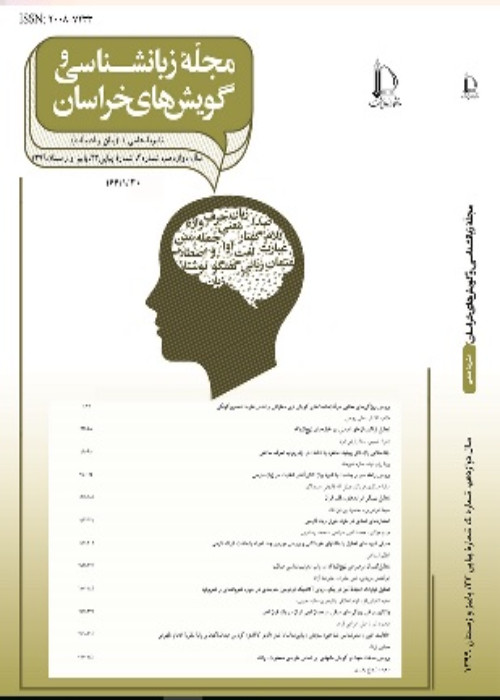Semantic Triggers of Various Meanings of Bread
Author(s):
Article Type:
Research/Original Article (دارای رتبه معتبر)
Abstract:
Introduction
When a word resembles the meaning of another word, both words are in the same ideal cognitive domain and follow a certain conceptual cognitive pattern. Such associations suggest important relations between these concepts that can be because of so many reasons like cultural priorities. Making a new association and eventually a new concept out of a new word, depends on the importance and the state of the association. Linguist's emphasis on the existence of focal and prominent meaningful entity for every single one of the concepts has been the fountain of many investigations for determining various meanings of a concept and its focal meaning in the form of semantic network.Theoretical Framework: Some similar researches involve: (Achresh & Jahromi, 2015), (Afrashi et al., 2012), (Afrashi et al., 2015), (Afshari & Samet, 2014), (Ghavam Esperghem, 2015), (Golshaieb et al., 2014), (Graf, 2011), (Hesabi, 2016), (Ibañez-Moreno, 2005), (Mousavi et al., 2015). (Nasib & Izanloo, 2016), (Rasekh Mahand & Ranjbar Zarabi, 2013), (Rezaee & Rafiee, 2016), (Seargeant, 2009), (Sorahi, 2012), (Zahedi & Mohammadi Ziyarat, 2011).The common point that can be found among these researches and similar ones is that they try to determine different meanings of a word and draw its semantic network. The point that has usually been ignored is the grounds or inspirations that these meanings originated from. In the current research, based on the assumption that meanings are inspired by concrete or abstract features (social, psychological, cultural, etc.), the motivations of the meanings of bread in Farsi are going to be investigated.
Methodology
For collecting different meanings of bread, 18 Persian dictionaries and a corpus containing more than 2,600,000 words were covered. Meanings were elicited by referring to dictionarie's explanation for that special entry, then the prominent feature of bread that played the most salient role in making the meaning, was gained. For instance, the idiom "naan-e sefid-e falak" that could literally be translated as "white bread of sky" means (is record ed in the dictionaries as) "moon". When it is asked what feature of bread has inspired this meaning, it leads to "appearance": Similarity between a white round bread and the moon. Therefore, the shape and appearance of bread has been the ground and motivation for this idiom.Results
In this research, the role of experience in creating various secondary meanings is studied. According to Fillmore (1982), meaningful elements in a language are created based on recurring experiences. Concepts are frames containing a collection of experiences that in contact with new phenomenon, one of their aspects can be triggered. On the other hand, for using the idiom "yek loghmeh naan"/"a bite of bread" meaning "a little amount of food or money", the concept of amount has been triggered, or in another idiom "nan-daani"/"bread's place" meaning "stomach", the place of bread has been triggered. Therefore, it can be said that tracing the semantic triggers of concepts leads to valuable information about different aspects of life and culture of societies.Conclusion
According to Lakoff and Johnson (2003), our conceptual system is the result of our interaction with our culture and physical environment. It is interesting that in some idioms the meaning of bread refers to high value and in some to low value. The low value of bread can be traced through history in periods that Farsi speakers were suffering from drought and famine and vice versa, the high value of bread can be traced in periods that this foodstuff has been abundant. This research showed that meanings are not arbitrary and there are not any meanings out of the circle of features and interaction concerning them. It approved results of Buccino, Colagè, Gobbi & Bonaccorso, (2016) that by neuro-physiological investigation and analyzing the linguistic meaning reached to the conclusion that neurological structure of brain of human is responsible for perceiving sensual, dynamic and emotional meaning of words that proves embodied meaning in linguistics. The most important role of embodiment is generating commonalities from experiences of various people in a language society. These experiences build the infrastructure of common linguistic meanings.Keywords:
Language:
Persian
Published:
Journal of Linguistics & Khorasan Dialects, Volume:9 Issue: 17, 2018
Pages:
153 to 174
magiran.com/p1846784
دانلود و مطالعه متن این مقاله با یکی از روشهای زیر امکان پذیر است:
اشتراک شخصی
با عضویت و پرداخت آنلاین حق اشتراک یکساله به مبلغ 1,390,000ريال میتوانید 70 عنوان مطلب دانلود کنید!
اشتراک سازمانی
به کتابخانه دانشگاه یا محل کار خود پیشنهاد کنید تا اشتراک سازمانی این پایگاه را برای دسترسی نامحدود همه کاربران به متن مطالب تهیه نمایند!
توجه!
- حق عضویت دریافتی صرف حمایت از نشریات عضو و نگهداری، تکمیل و توسعه مگیران میشود.
- پرداخت حق اشتراک و دانلود مقالات اجازه بازنشر آن در سایر رسانههای چاپی و دیجیتال را به کاربر نمیدهد.
In order to view content subscription is required
Personal subscription
Subscribe magiran.com for 70 € euros via PayPal and download 70 articles during a year.
Organization subscription
Please contact us to subscribe your university or library for unlimited access!


